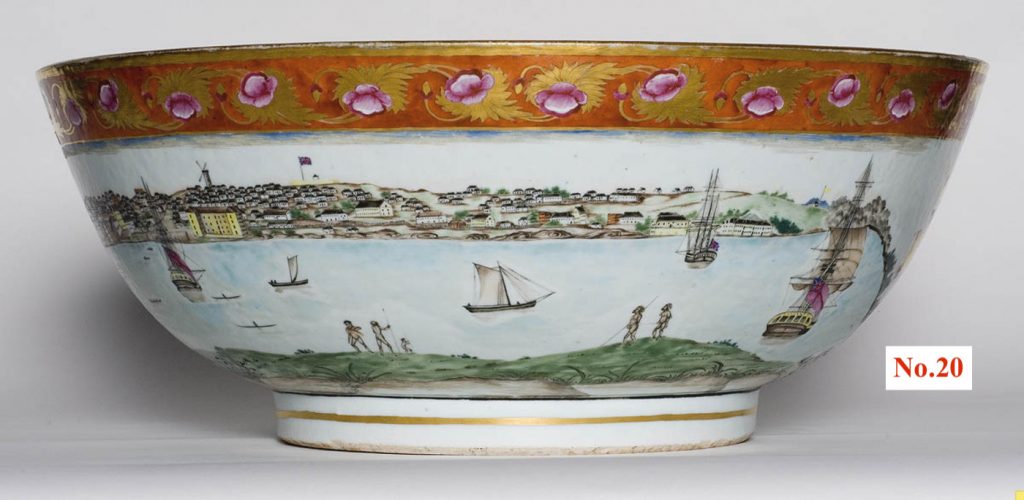
This colourful scene of Sydney harbour from around 1820 finds itself depicted on a large punchbowl that was manufactured in the Chinese port city of Canton (Guangzhou 廣州). As a punchbowl this is one of many China made products produced specifically for export to Europe and so represents the growing establishment of European-China trade centred on Canton in the years before the Opium Wars and the establishment of Hong Kong. The use of an engraving of the small British colony at Port Jackson – only established a generation previously – highlights the strong link with China that existed from the beginning of this British colony long before its gold rushes of a subsequent generation.
This China-Australia link began with the very ships of the First Fleet, some of which were hired from the East India Company and after delivering their convict passengers proceeded to Canton to continue as carriers of trade. The relative proximity of Canton to Port Jackson soon meant that much needed supplies and later trade, predominantly seal fur at first, between China and the British colony was carried on. So much so that when Commissioner Bigge made his report on the condition of the colony in 1815 he decried the high consumption of tea (which he considered a luxury unfitting for a convict colony) to ‘the existence of an intercourse with China from the foundation of the Colony …’ [1]
This proximity and the ongoing trade and its necessary shipping meant that Chinese people themselves were present in Sydney in various capacities. Much has been made recently of Mak Sai Ying (aka John Shying) as the ‘first’ such person. This he undoubtedly was not – but the relative wealth of information about him, his Parramatta pub and his descendants all make him a symbol of the beginning of the Chinese in Australia far more powerful than mere historical detail. A variety of people now known to us simply as “3 Chinese” or “Chinese lascars” were reported in the colony and no doubt others too arrived to work and trade in the first years of Port Jackson.
Such people travelled not via the then largely unpopulated island of Hong Kong but via the wealthy city of Canton further up the Pearl River Delta where the presence of European factories were allowed under sufferance of the Emperor’s will. These European factories employed Chinese labour to make many goods such as the “Canton punchbowl” for export to European markets. The quality of the Chinese ceramic and the exotic colonial scene would have made this piece a marketable item. Though only two are now known to exist.
This relatively peaceful trading scene was transformed when the British won the first Opium War (1839-40) which not only forced the maintenance of an open market in opium but established Hong Kong as a British port and opened up trade in a number of other so-called Treaty Ports such as Amoy (Xiamen, 夏曼). [See No. 59] This in turn opened up far greater links between China and the British colonies of Australia with at first indentured labourers through the Port of Amoy and subsequently seekers of gold through the Port of Hong Kong making their impact upon the Australian colonies.
[1]‘Bigge Report, Remarks on Distillation, 28/1/1821.
See also:
‘Chinese export porcelain from the wreck o f the Sydney Cove (1797)’ Australian Institute for Maritime Archaeology, Special Publication No.12, 1998, pp.7-9
Fei, Sheng, The Opening of Maritime Routes Connected Oceania to China in the Late Nineteenth Century– 费晟 – 中山大学历史学系副教授, Studies of Maritime History, Vol.12., 2018.

